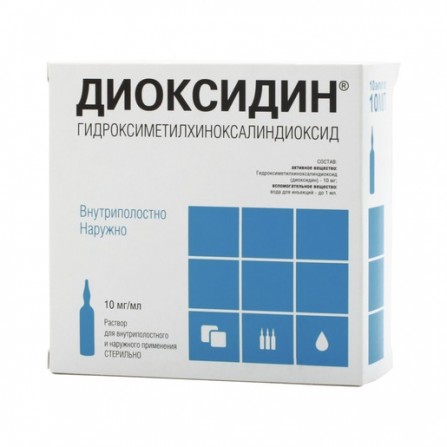Dioxidine solution for intracavitary and external use of 10 mg ml ampoules 10 ml 10 pcs
Condition: New product
995 Items
Rating:
Be the first to write a review!

More info
Active ingredients
Hydroxymethylquinoxalinedioxide
Release form
Solution
Composition
Active ingredient: Hydroxymethylquinoxalindioxide (Hydroxymethylchinoxalindioxydum) Active ingredient concentration (mg): 100
Pharmacological effect
A broad-spectrum antibacterial drug from the group of quinoxaline derivatives, possesses chemotherapeutic activity in infections caused by vulgar proteem, dysenteric bacillus, klebsiella, syringic bacillus, salmonella, staphylococcus, streptococci, pathogenic anaerobes (including the pathogens, gano-gannula, streptococci, pathogenic anaerobes (including the pathogens, gum, salmonella, staphylococci, streptococci, pathogenic anaerobes) bacteria that are resistant to other chemotherapy drugs, including antibiotics. The development of drug resistance of bacteria is possible. With the on / in the introduction is characterized by a small therapeutic breadth, and therefore requires strict adherence to the recommended doses. Treatment of burns and purulent-necrotic wounds contributes to a more rapid cleansing of the wound surface, stimulates reparative regeneration and marginal epithelization, and favorably affects the course of the wound process.
Pharmacokinetics
When applied topically, it is partially absorbed from the wound or burn surface, excreted by the kidneys.
Indications
Purulent bacterial infections caused by sensitive microflora with the ineffectiveness of other chemotherapeutic agents or their poor tolerance. External use - superficial and deep wounds of various localization; - nonhealing wounds and trophic ulcers; - soft tissue phlegmon; - infected burns; - purulent wounds with osteomyelitis. Intracavitary injection - purulent processes in the chest and abdomen; - with purulent pleurisy, pleural empyema, lung abscesses, peritonitis, cystitis, wounds with the presence of deep pressure oyonal cavities (soft tissue abscesses, pelvic cellulose phlegmon, postoperative wounds of the urinary and biliary tracts, purulent mastitis).
Contraindications
- adrenal insufficiency (including a history); - pregnancy; - lactation period; - children's age; - hypersensitivity to dioxidine.
Precautionary measures
Do not exceed recommended doses.
Use during pregnancy and lactation
Contraindicated in pregnancy and lactation.
Dosage and administration
Dioxidine prescribed in the hospital.Applied externally, vnutripolostnost. 1% Dioxidine solution can not be used for intravenous administration, due to the instability of the solution during storage at low temperatures. External use Apply 0.1-1% Dioxidine solutions. To obtain a 0.1-0.2% solution, the ampoule solutions of the drug are diluted to the desired concentration with sterile isotonic sodium chloride solution or water for injection. For the treatment of surface infected purulent wounds, wipes moistened with a 0.5-1% dioxidine solution are applied to the wound. Deep wounds after treatment, loosely tamped with tampons moistened with 1% dioxidine solution, and in the presence of a drainage tube, 0.5 to 0.5 ml of the preparation solution is injected from 20 to 100 ml into the cavity. For the treatment of deep purulent wounds with osteomyelitis (hand, foot wounds) 0.5-1 is used % solutions of the drug in the form of baths or spend a special treatment of the wound with a solution of the drug for 15-20 minutes (introduction of a solution into the wound for this period), followed by dressing with 1% dioxidine solution. Dioxidin 0.1-0.5% solutions can be used for prevention in projections after surgery. According to indications (patients with osteomyelitis) and with good tolerance, treatment can be carried out daily for 1.5-2 months. Intracavitary injection 10-50 ml of 1% dioxidine solution / day is administered to the purulent cavity, depending on its size. The dioxidine solution is injected into the cavity through a catheter, drainage tube or syringe. The maximum daily dose for introduction into the cavity is 70 ml of a 1% solution. The drug is usually injected into the cavity once a day. According to indications, it is possible to introduce a daily dose in two doses. With good portability and availability of evidence, the drug can be administered daily for 3 weeks or more. If necessary, in 1-1.5 months they conduct repeated courses.
Side effects
With intracavitary administration, headache, chills, fever, dyspeptic disorders, muscle cramping, allergic reactions, photosensitizing effect (the appearance of pigmented spots on the body when exposed to sunlight) are possible. When applied externally, it is near-edge dermatitis.
Overdose
Cases of overdose are not described.
Interaction with other drugs
Not noted. The attending physician should be informed of all medications taken.
special instructions
Dioxidine is prescribed only for adults. Before the start of the course of treatment, a test is carried out on the tolerability of the drug, for which 10 ml of a 1% solution is injected into the cavities. If there are no side effects (dizziness, chills, fever) within 3-6 hours, a course treatment is started. Dioxidine is prescribed only for severe forms of infectious diseases or for the ineffectiveness of other antibacterial drugs, including cephalosporins II-IV generations, fluoroquinolones, carbapenems. In chronic renal failure, the dose is reduced. In case of pigment spots, the duration of a single dose is increased to 1.5-2 hours, the dose is reduced, antihistamines are prescribed or Dioxidine is canceled. the solution during storage (at a temperature below 15 ° C) they are dissolved by heating the ampoules in a boiling water bath with shaking until the crystals completely dissolve (clear solution). If during cooling to 36-38 ° C the crystals do not fall out again, the drug is usable.



